A woman’s hand and a horse’s tooth should never stand still
A woman’s hand and a horse’s tooth should never stand still
In Dutch, there is a saying: ‘A woman’s hand and a horse’s tooth should never stand still.’ It means that a healthy woman should always work and a healthy horse should always eat. Mind you, these are not my words. After all, I do not want all women to revolt because there is a saying like this. But this old saying was certainly right about the ‘horse’s tooth’, or better, the jaw joint.
First of all, I want to tell you something about the skull. The temporomandibular joint is a part of the skull. The skull is the most complex bone in the body. It covers and protects the brain and houses a number of senses: sight, hearing, taste and smell. In addition, it gives access to the digestive system and the lungs.
The cerebrospinal fluid (created by filtration of blood) is also located in the skull, surrounding the brain and the spinal cord. Important functions of this fluid include:
• Protection of the brain and spinal cord
• Supply of nutrients to nerve cells
• Disposal of waste from nerve cells
• Immunological protection
Osteopathic treatment of cerebrospinal fluid can lead to;
• Relaxation of connective tissue throughout the body
• Hormonal harmonization
• Relaxation of the skull
• Mental relaxation for anxiety, depression and stress
The skull consists of several parts that – when the cerebrospinal fluid starts to move – move somewhat like the tide. This is an important part of my therapy. Every movement of each individual part of the skull has an effect on the adjacent part of the skull. The same applies to the temporomandibular joint. I’d like to explain a major and frequently occurring problem below.
I regularly encounter ‘neck problems’ in horses. Often this concerns the first and the second cervical vertebra. A problem in the region of the 1st and 2nd cervical vertebra has an immediate effect on the temporomandibular joint and the teeth. As the first grinding movement of the temporomandibular joint occurs in this region, a deviation in the teeth can arise from a problem in the neck.
Because the occipital skull is directly linked to the first cervical vertebra, a ‘neck problem’ also has a big influence on the occipital skull. It can have a serious effect on the entire horse, if it cannot move freely in the skull. As the occipital skull is moved by the cerebrospinal fluid, a problem of the occipital skull also directly affects the cerebrospinal fluid. Thus, movement of the cerebrospinal fluid can affect the entire skull and all inner structures, including the pituitary gland (hormone regulation). But it can also affect the central nervous system. As the cerebrospinal fluid flows through the spinal cord, the entire body, including the organs, can have an effect on this.
This occipital skull is difficult to treat. However, it can be treated well with the right techniques and especially with the right intention and feeling.
Possible symptoms of jaw and occipital skull problems:
• Headache
• Recurring dental abnormalities
• Hormonal problems
• Direct influence of the occipital skull on the SI joint
• High and painful tension around the temporomandibular joint
• Headshy
• Contact problems
• Head tilting
• Back / saddle problems
• Behavioral problems, depression, anxiety, nervousness, stress …



